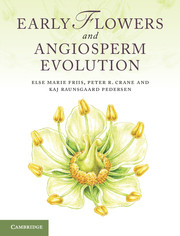Book contents
- Frontmatter
- Contents
- Preface
- 1 Introduction to angiosperms
- 2 The nature of the angiosperm fossil record
- 3 The environmental context of early angiosperm evolution
- 4 Stratigraphic framework and key areas for Cretaceous angiosperms
- 5 Angiosperms in context: extant and fossil seed plants
- 6 Origin and age of angiosperms
- 7 Phylogenetic framework and the assignment of fossils to extant groups
- 8 Fossils near the base of the angiosperm tree
- 9 Early fossil angiosperms of uncertain relationships
- 10 Early fossils of eumagnoliids
- 11 Fossils of monocots
- 12 Fossils of eudicots: early-diverging groups
- 13 Fossils of core eudicots: basal lineages
- 14 Fossils of core eudicots: rosids
- 15 Early fossils of eudicots: asterids
- 16 Patterns of structural diversification in angiosperm reproductive organs
- 17 History and evolution of pollination in angiosperms
- 18 History and evolution of dispersal in angiosperms
- 19 Vegetational context of early angiosperm diversification
- 20 The accumulation of angiosperm diversity
- References
- Index
16 - Patterns of structural diversification in angiosperm reproductive organs
Published online by Cambridge University Press: 07 September 2011
- Frontmatter
- Contents
- Preface
- 1 Introduction to angiosperms
- 2 The nature of the angiosperm fossil record
- 3 The environmental context of early angiosperm evolution
- 4 Stratigraphic framework and key areas for Cretaceous angiosperms
- 5 Angiosperms in context: extant and fossil seed plants
- 6 Origin and age of angiosperms
- 7 Phylogenetic framework and the assignment of fossils to extant groups
- 8 Fossils near the base of the angiosperm tree
- 9 Early fossil angiosperms of uncertain relationships
- 10 Early fossils of eumagnoliids
- 11 Fossils of monocots
- 12 Fossils of eudicots: early-diverging groups
- 13 Fossils of core eudicots: basal lineages
- 14 Fossils of core eudicots: rosids
- 15 Early fossils of eudicots: asterids
- 16 Patterns of structural diversification in angiosperm reproductive organs
- 17 History and evolution of pollination in angiosperms
- 18 History and evolution of dispersal in angiosperms
- 19 Vegetational context of early angiosperm diversification
- 20 The accumulation of angiosperm diversity
- References
- Index
Summary
This chapter provides an overview of the main patterns of structural diversification in angiosperm flowers as inferred from the occurrence of floral features in the fossil record in the context of phylogenetic analyses of angiosperm relationships (Chapter 7). The systematic chapters (Chapters 8–15) provide descriptions of the individual fossils and cite the relevant literature. Here we focus on broader patterns, the appearance of major structural novelties and, where possible, what these imply about floral innovation among angiosperms as a whole. In part these large-scale patterns in the evolution of floral structure reflect the successive diversification of different lineages of angiosperms at different times in the past. The consequences of floral innovation for angiosperm pollination and dispersal biology are considered in Chapters 17 and 18. Aspects of the diversification of reproductive structure in specific angiosperm lineages are addressed in Chapter 20.
Building on earlier work by Brenner (1963), Muller (1970) and others, studies in the 1970s on early angiosperms from the Potomac Group of eastern North America were the first to demonstrate a coordinated increase in the diversity and ‘advancement’ of pollen and leaves through the Early and mid-Cretaceous (Doyle and Hickey, 1976; Hickey and Doyle, 1977; Hickey, 1978). This work confirmed that monoaperturate angiosperm pollen appeared first in the fossil record, an observation that was (and remains) consistent with phylogenetic concepts based on extant plants. A parallel increase in the structural complexity of fossil angiosperm leaves was also broadly consistent with interpretations of the evolution of leaf architecture among extant taxa (Hickey and Wolfe, 1975; Doyle and Hickey, 1976; Hickey and Doyle, 1977).
- Type
- Chapter
- Information
- Early Flowers and Angiosperm Evolution , pp. 387 - 414Publisher: Cambridge University PressPrint publication year: 2011

